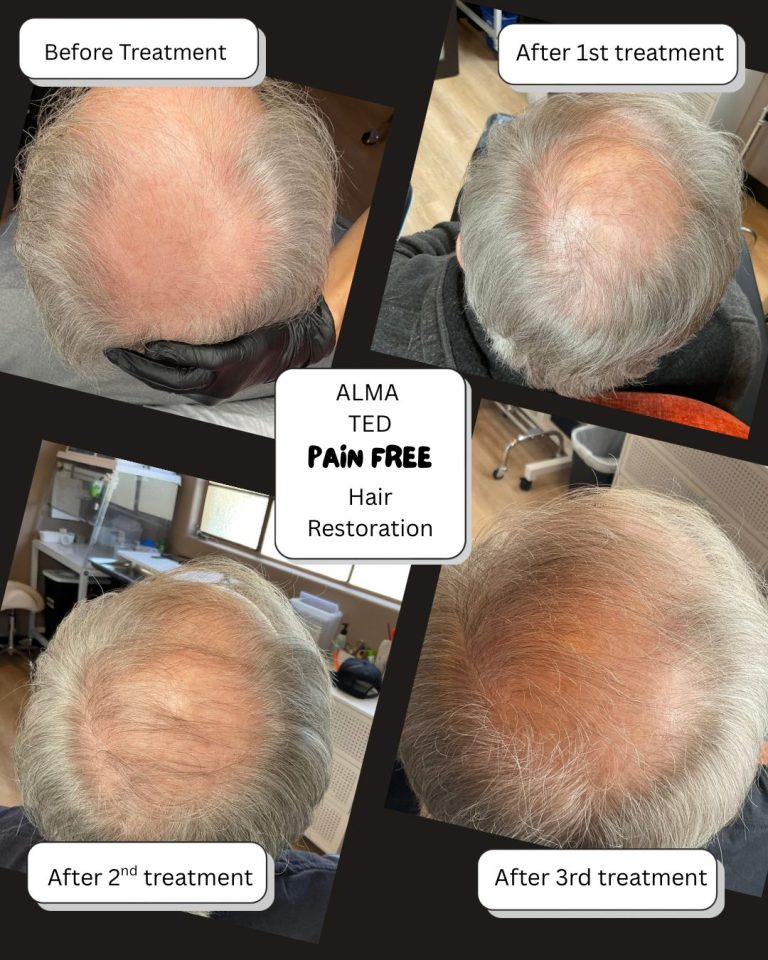Hair Restoration
Hair Restoration

AlmaTED Hair Restoration:
No trauma. No discomfort. A comfortable patient experience unlike other in-office treatments that involve trauma to the scalp.
Noticeable results in one treatment
– Patients will experience noticeable results in as early as 2 weeks
Quick and Simple
– A quick 20-30 minute treatment session requiring no topical anesthetic
$1,200 per session
$3,300 pre-paid for 3 sessions
Annual touch-up $1,000
PRP Boost:
PRP is derived from your own blood and is rich in growth factors, which can promote healing and tissue regeneration. The process involves concentrating platelets and other healing components found in your blood
$500/treatment
VAMP Boost:
$400/treatment
These products are not intended to diagnose, treat, cure, or prevent any disease.
Reliance on or use of this information provided on this website is at your own risk.
AlmaTED Hair Restoration
Contraindications
• Patients with an implanted medical device other than a pacemaker such as implanted deep brain stimulation device
• Near brain, cervical ganglia, spine, laminectomy sites (can cause spinal-cord heating)
• Near the reproductive organs
• Total hip arthroplasties with methylmethacrylate or high-density polyethylene.
These have a high coefficient of absorption, more than soft tissue, and the prosthesis could loosen due to unstable cavitation in the cement
• Arthroplasties—the effect on bony ingrowth arthroplasties is not well defined; for this reason the most prudent course is avoiding ultrasonic therapy over these areas
• Over or near bone growth centers until bone growth is complete
• Over the thoracic area if the patient is using a cardiac pacemaker
• In an area of the body where a malignancy is known to be present
• In an area of the body where infectious disease is present
• Blood vessels in poor condition should not be treated as the vessel walls could rupture as a result of the treatment
• Patients with thrombophlebitis or other potentially thromboembolic diseases should not be treated because a partially disintegrated clot could result in an obstruction of the arterial supply to the brain, heart or lungs
• Over a healing fracture
• Over the eye
• Over the pregnant uterus
• Over ischemic tissues in individuals with vascular disease where the blood supply would be unable to follow the increase in metabolic demand
• Over areas of recent bleeding or hemorrhage
• Over areas of active tuberculosis
The use of the TED system may cause:
• Heating sensation – Patient may experience a heating sensation during or just following the treatment, however, such pain is expected to be mild and to resolve within few minutes.
• Erythema – Redness in the treatment area is expected and should disappear within 24 hours
• Burns – Rare occurrence and should be treated conventionally
• Tinnitis
Hair Restoration Injections (e.g., PRP)
Common Side Effects:
- Pain or discomfort at the injection site
- Swelling or redness
- Bruising
- Headaches
Less Common Side Effects:
- Infection (rare)
- Allergic reactions (if additives are used)
- Nerve damage (very rare)
Microneedling
Common Side Effects:
- Redness or swelling similar to a mild sunburn
- Sensitivity in the treated area
- Minor bleeding (often small pinpoint spots)
- Crusting or scabbing
Less Common Side Effects:
- Infection (if not done in sterile conditions)
- Hyperpigmentation (especially in darker skin types)
- Scarring (if not performed correctly)
General Considerations
- It’s important to choose a qualified professional to minimize risks.
- Discuss your medical history and any concerns beforehand.
- Follow post-treatment care instructions to reduce the risk of side effects.
Before & After Photos


